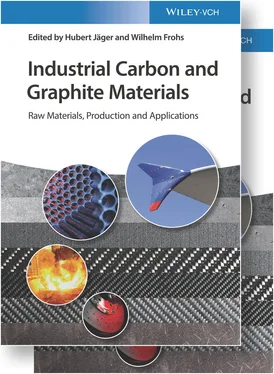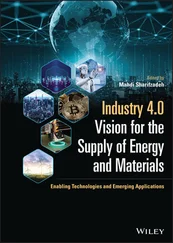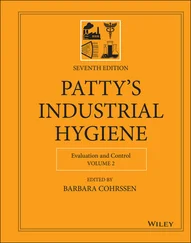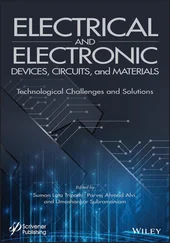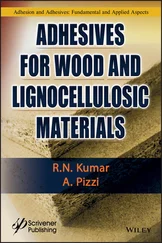1 ...8 9 10 12 13 14 ...53 Graphite electrodes are exposed to extreme conditions during the melting of steel. From a tip temperature of several thousand degrees centigrade, the temperature falls to about 1000 °C close to the roof of the furnace and to a few hundred degrees centigrade on top of the roof. Lengthwise and transversal temperature gradients create extensive thermal stresses. These high stresses initiate material cracks that can lead to severe material losses during the melting process ( Figure 1.5).
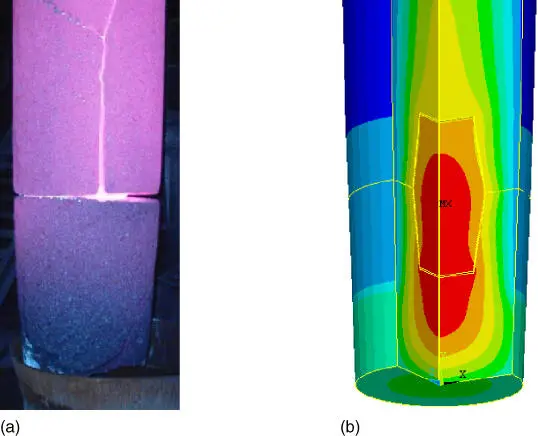
Figure 1.5 Graphite electrode. (a) Graphite electrode with crack in the joint area. (b) Finite element simulation of temperature distribution.
The biggest disadvantage of these graphite losses is the expensive interruptions in the steel production chain. Thus the efforts of the graphite electrode producers focused on the minimization of these losses by the use of improved raw materials improved the process consistency, impacting the thermal compatibility between the connecting pin and the graphite electrode. These are only some approaches to minimize material losses and to enable a high efficiency of the scrap melting process. Although graphite electrodes have been produced since almost hundred years, the complete understanding was never accomplished.
Carbon electrode means a solely baked and not graphitized electrode composed of calcined anthracite and or synthetic graphite. These prebaked electrodes are an alternative to the Söderberg electrodes, a green paste that is baked and graphitized during its application in the EAF. Carbon electrodes reach diameters up to 1400 mm ( Figure 1.6). They are mainly used for the production of metallic silicon and phosphorus. Notably the production of silicon doubled in between 1990 and 2010 ( Figure 1.7). The strongest driver was the solar industry. The number of carbon electrode producers is rather small ( Figure 1.8). The estimated carbon electrode production capacity is slightly above the demand. This free capacity will soon be covered as the demand for silicon will further grow with the ongoing installation of solar panels. As in the case of graphite electrodes, the customer expects a smooth operation without excessive consumption.
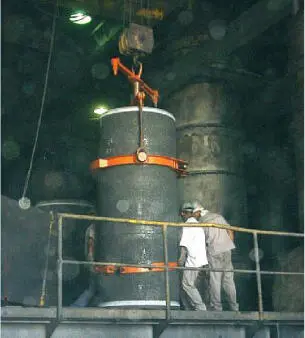
Figure 1.6 Carbon electrodes with diameters up to 1400 mm.
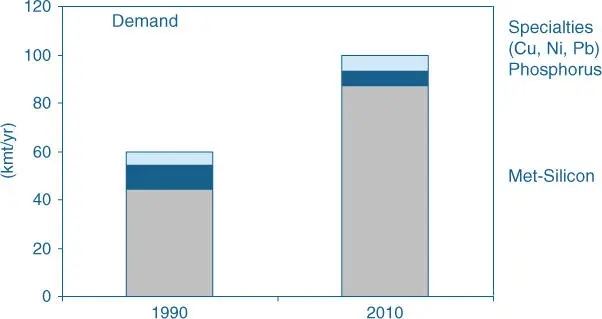
Figure 1.7 The demand for carbon electrodes.
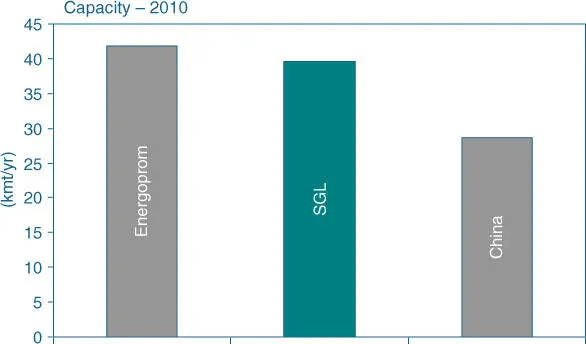
Figure 1.8 Carbon electrode producer and capacity. SGL: Since 2018 COBEX.
Cathodes build the bottom of the Hall–Héroult electrolysis cell for the production of primary aluminum. This process was developed in 1886 and is still unchanged in its basic principles today. Alumina is reduced in a cryolite bath electrochemically to elemental liquid aluminum ( Figure 1.9). The electric current passes through the bath to the anode electrode on top of the cell. The anodes were consumed during this electrochemical process and react to CO 2. The anode consumption per ton of aluminum is in average 0.47 t. For the production of 41 million t of aluminum in the year 2011, the demand for carbon anodes is 19.3 million t. Aluminum is strongly growing with an expected annual rate of about 8% in 2011 and the following years. One main driver is the automotive industry to replace steel components for lightweight construction.
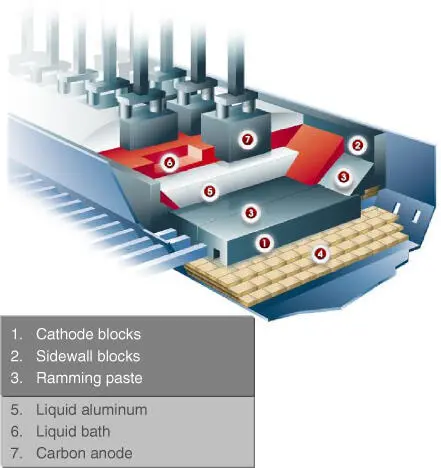
Figure 1.9 Aluminum electrolysis cell.
Due to the design of the electrolysis cell, three types of cathodes are in use. The old cathode type is the amorphous type consisting mainly of calcined anthracite and is solely baked. Graphitic cathodes contain a high content of synthetic graphite and are also solely baked. The graphite cathodes are made from coke and are graphitized to a definite temperature. This temperature provides the desired electrical and thermal conductivity. It is needless to say that the demand for cathodes was growing in the last decades ( Figure 1.10). All grades did benefit but by far the strongest growth was noticed for graphite cathodes. Cathode producers are located in Europe, Japan, Russia, and China ( Figure 1.11).
The main reason for the existence of the different types of cathodes is the height of the applied electrical power. The increase in amperage over the years is shown in Figure 1.12. The market introduction of graphite cathodes happened in the 1970s and enabled with its lower electrical resistivity the further increase in amperage and thus improved the efficiency of the cell. In spite of being an old process, many efforts are ongoing to drive the production of aluminum on the edge in productivity, durability of the cell, and energy efficiency. New processes that are under development are coatings with TiB 2to improve the wettability of carbon by the liquid aluminum. The drained cell design should reduce the distance between the cathode bottom and the anode above. The target is to improve the stability of the current flow and thus to increase the cell efficiency. The carbothermic process is a direct reduction of alumina by carbon under heat. All efforts to replace the anode by a so‐called non‐consuming inert anode failed so far. The bath conditions are so severe that no other material than carbon was yet demonstrated to survive.
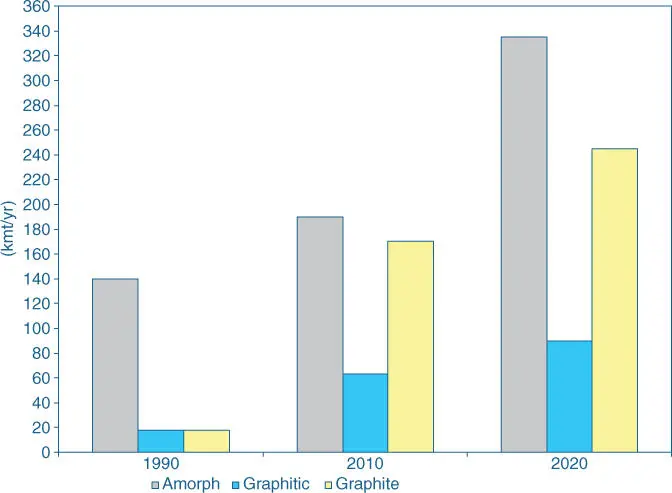
Figure 1.10 Cathode production by grade.
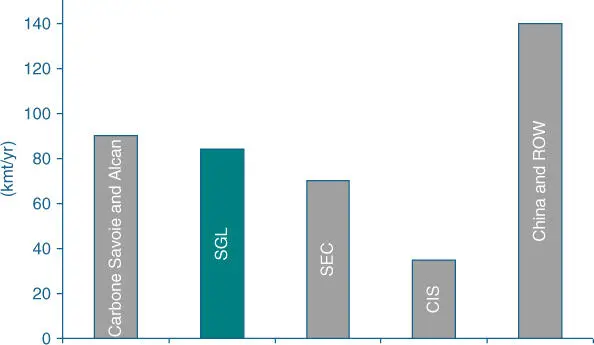
Figure 1.11 Cathode producers and their capacity. SGL: Since 2018 COBEX.

Figure 1.12 Increase in cell amperage over the last 70 years.
Carbon and graphite bricks are used to construct the hearth of a blast furnace and basic oxygen furnace (BOF) for the production of iron and steel. Carbon and graphite materials are first choice in a chemically aggressive environment at high temperatures ( Figure 1.13). The demand for blast furnace steel was consistently growing on a global basis, but the regional developments are different ( Figure 1.4). The growth flattened in the 1970s in the Western economies including Japan. The growth happened from there on in Asia, first went to South Korea, then to China, and later to India. The production capacities for furnace linings are located in Germany and Japan, as well as in China and Russia ( Figure 1.14).
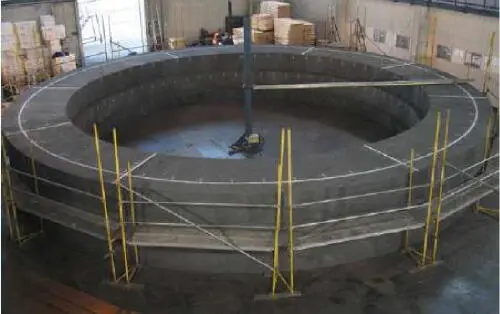
Figure 1.13 Test assembling of a blast furnace lining.
Читать дальше
